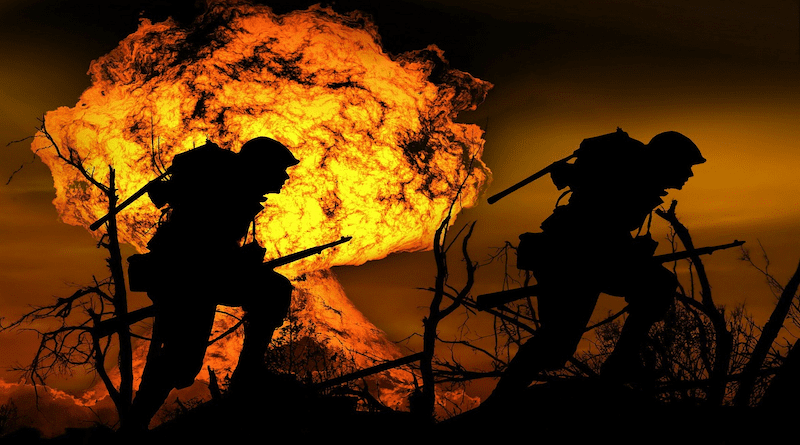Observing September 26 In The Shadow Of Nuclear Risks – Analysis
By Observer Research Foundation
By Dr. Manpreet Sethi*
September 26 is observed every year as UN International Day for the Total Elimination of Nuclear Weapons. The tradition has continued for nine years since the UN General Assembly passed Resolution 68/32 as a follow-up to its high-level meeting on nuclear disarmament, held on 26 September 2013 in New York. The aim of designating a day of this kind is to raise global public awareness about nuclear weapons threats and the necessity of their total elimination, to liberate humanity from being a prisoner to the possibility of extinction due to nuclear war. The day is meant to be commemorated by holding events that can educate the public, and their leaders, about the socioeconomic as well as ecological costs that will have to be borne if such weapons of mass destruction are used.
As part of the observances of events for this year, the UN General Assembly hosted a High Level Meeting on Nuclear Disarmament at UN Headquarters on September 26. UN member states were represented by their presidents, prime ministers, and foreign ministers or UN ambassadors. The UN Secretary General said at the event, “We come together on this international day to speak with one voice. To stand in defence of our world ¾ and our future. And to reject the claim that nuclear disarmament is some impossible utopian dream.” Several civil society organisations also conducted many events to draw attention to the need to get rid of nuclear weapons.
Meanwhile, the biggest reality nuclear show of the year is taking place in the context of the ongoing Russia-Ukraine conflict. Nuclear threats have been made several times—the most recent was on 21 September 2022, with President Putin hinting at nuclear weapons use as part of a statement that threatened to “use all the means at our disposal.” This expression came after Russia faced tactical military reverses in mid-September.
US Secretary of State Anthony Blinken responded to these veiled threats with the promise of huge consequences. US National Security Advisor Jake Sullivan said, “We have communicated directly, privately at very high levels to the Kremlin that any use of nuclear weapons will be met with catastrophic consequences for Russia, that the United States and our allies will respond decisively, and we have been clear and specific about what that will entail.” President Biden, too, publicly and sternly cautioned Russia against going down the nuclear path. Several other world leaders also used UNGA speeches around 26 September to criticise loose references to use of nuclear weapons for nuclear blackmail.
As part of this publicly unfolding drama, attention to nuclear weapons and their dangers is perhaps at its highest since the 1962 Cuban Missile Crisis. October 2022 will mark six decades of the US and USSR first facing the spectre of nuclear war. Large dollops of good luck and the wisdom of leaders scraped the two countries, and the rest of the world, past that hair-raising episode.
As tensions wound down, both countries made sincere efforts over the following decades to evolve necessary mechanisms to minimise the possibility of such an eventuality. Several arms control treaties and arrangements, concluded through laborious negotiations, were to serve as guard rails against states skidding to the edge of the precipice again. These treaties did cast a constraining influence over the actions of those states that were parties to them. But, from the time the US decided to walk-out of the Anti-Ballistic Missile (ABN) Treaty in 2002, the architecture has slowly unravelled, treaty by treaty. The maximum backsliding took place during President Trump’s term. When he left office, the US and Russia were left hanging onto one slender thread of the New Strategic Arms Reduction Treaty (START). President Biden moved quickly to reinforce it but it was too little, too late.
The current nuclear reality between the major nuclear powers is dotted with offence-defence spirals, increasing chasms in their understanding of how to practice nuclear deterrence, unrestrained technological developments, and a fast-growing fuzziness between conventional and nuclear capabilities. The result of all this is clear. The world seems to be on a slow march not towards the elimination of nuclear weapons, but towards their modernisation and greater role in national security.
Rational reasoning tends to presume that despite these developments, no leader will ever be able to find it easy or useful to use these weapons. It is equally well-known however that in conflict situations, rational reasoning could easily go missing. The question, therefore, that lurks in every mind is: “What if circumstances conspire towards an accident or a miscalculation?” There is no definitive answer.
It is for this reason that days like 26 September are important. Interestingly, the day also marks the anniversary of another incident: when the world yet again came close to nuclear war in 1983. A malfunction in the Soviet nuclear weapons early warning system led it to erroneously detect a US ballistic missile attack against Moscow. Thankfully, the Soviet ‘nuclear guard’ on duty refused to accept what the system was telling him at face value, and chose not to automatically launch nuclear retaliation. Human wisdom came to the rescue once again. Will we find the ‘right thinking’ people occupying important chairs every time?
The significance of recalling these incidents and celebrating such days is to bring the dangers of nuclear weapons, and all that can inadvertently go wrong, into our consciousness once again. The idea is to spend a moment revisiting the horrors of deterrence breakdown—calamities that we could bring upon ourselves—because these weapons exist. Even more alarmingly, they are now spread across many arsenals and at varying levels of readiness. Can we, or should we, keep tempting fate every few decades? And will we live to tell the tale each time?
*Dr. Manpreet Sethi is Distinguished Fellow at the Centre for Air Power Studies (CAPS), New Delhi.

